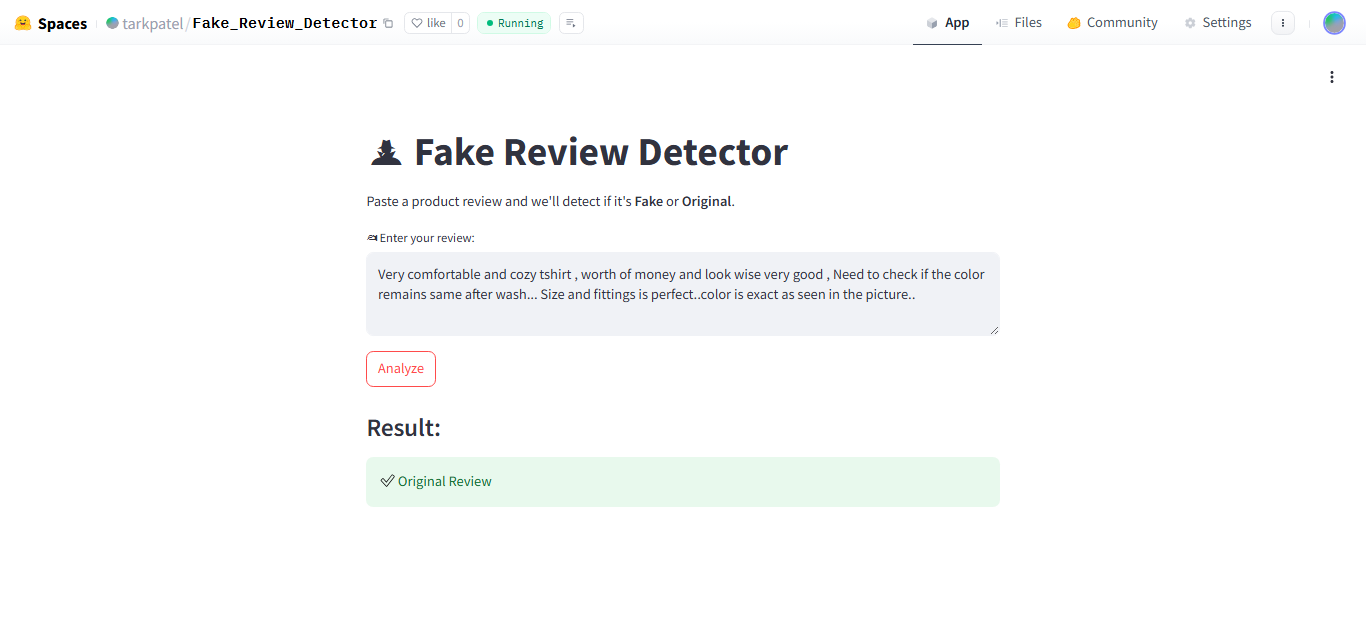Fake Product Review Detector
🚀 1. Overview / Summary (The Elevator Pitch)
Fake product reviews have become a serious issue in today’s e-commerce world, misleading customers into making poor buying decisions.
I set out to solve this problem by building a Fake Product Review Detector — a lightweight, ML-powered web application where users can input any review text and instantly find out if it’s fake or genuine.
Built using Streamlit and a custom trained machine learning model, the app is fast, easy to use, and aims to bring more trust to online shopping.
🌍 2. Live Demo
- 🔗 Live demo: Hugging Face Spaces
- 🔗 GitHub Repository: GitHub Link
❓ 2. Problem Statement / Motivation
With millions of products being sold online, it’s nearly impossible for customers to manually identify which reviews are authentic.
Fake reviews can manipulate customer trust, inflate product ratings, and result in wasted money and bad experiences.
Motivation:
I wanted to work on a real-world problem that merges machine learning and ethical AI — creating a tool that helps people make smarter and safer shopping decisions.
📚 3. Dataset
For training the Fake Review Detection model, I used a publicly available dataset on Kaggle containing product reviews labeled as fake or genuine.
Each review is associated with a label that indicates its authenticity, allowing the model to learn the subtle patterns between fake and real reviews.
Key Features of the Dataset:
- Text-based reviews
- Labels: 0 (Genuine), 1 (Fake)
- Moderate size (~few thousand entries)
🛠️ 4. Methodology / Approach
Here’s how I approached solving the problem:
- Data Cleaning and Preprocessing:
- Removed stopwords, punctuation, and performed lowercasing.
- Tokenized and vectorized the text (using TF-IDF).
- Model Building:
- Trained a simple yet effective classification model using RandomForest Classifier (best trade-off between performance and speed).
- Evaluated multiple models and chose the one with the best validation accuracy.
- Web Application:
- Built an intuitive front-end using Streamlit.
- Users input a review and receive a prediction in real time.
- Deployment:
- Streamlined the app for lightweight deployment and quick access.
- Streamlined the app for lightweight deployment and quick access.
📈 5. Results and Key Findings
- Achieved a validation accuracy of around 88%, making the model fairly reliable for real-world usage.
- The model successfully captures patterns such as overly promotional language, suspicious repetition, and unnatural writing styles common in fake reviews.
- Created a web app that is simple, fast, and effective — users can get results within seconds.
Key Learning:
Even simple models, when applied thoughtfully, can solve real-world problems effectively.
🚀 7. Challenges and Solutions
| Challenge | Solution | |
|---|---|---|
| Handling noisy and inconsistent review data | Applied thorough text preprocessing and experimented with different NLP techniques. | |
| Balancing model complexity with deployment speed | Chose models like RandomForest Classifier over heavy deep learning models to ensure quick predictions. | |
| Building a clean user interface | Used Streamlit for its simplicity and rapid prototyping features. |
🔮 8. Future Work / Improvements
- Expand Dataset: Train the model on a larger and more diverse set of product reviews. Integrate Product Review APIs: Automatically fetch all reviews for a product (using APIs like Amazon Product Advertising API or RapidAPI services) so users can analyze multiple reviews at once instead of manually entering text.
- Model Improvements: Experiment with more advanced NLP models like BERT or LSTM for even higher accuracy.
🌟 Final Thoughts
Building this project taught me the real-world impact of applying AI for social good.
It also showed me that sometimes small, focused tools can make a big difference in people’s daily lives.
I’m excited to continue exploring projects where Machine Learning meets everyday human trust.
Thank you for reading! 🚀
